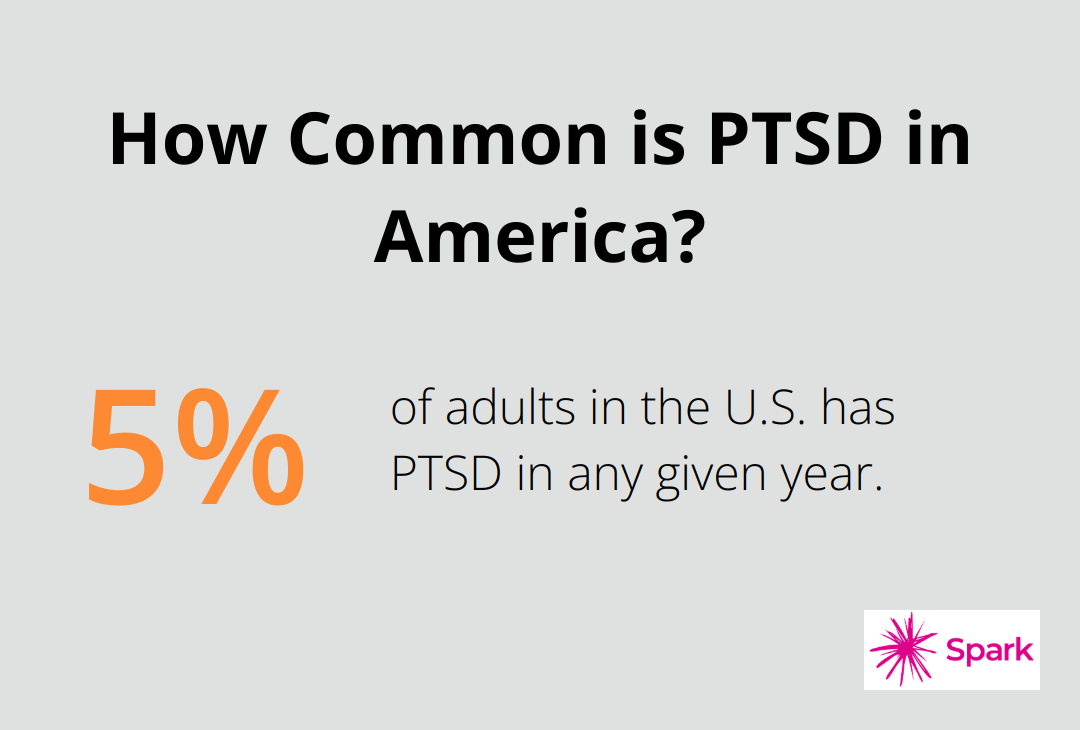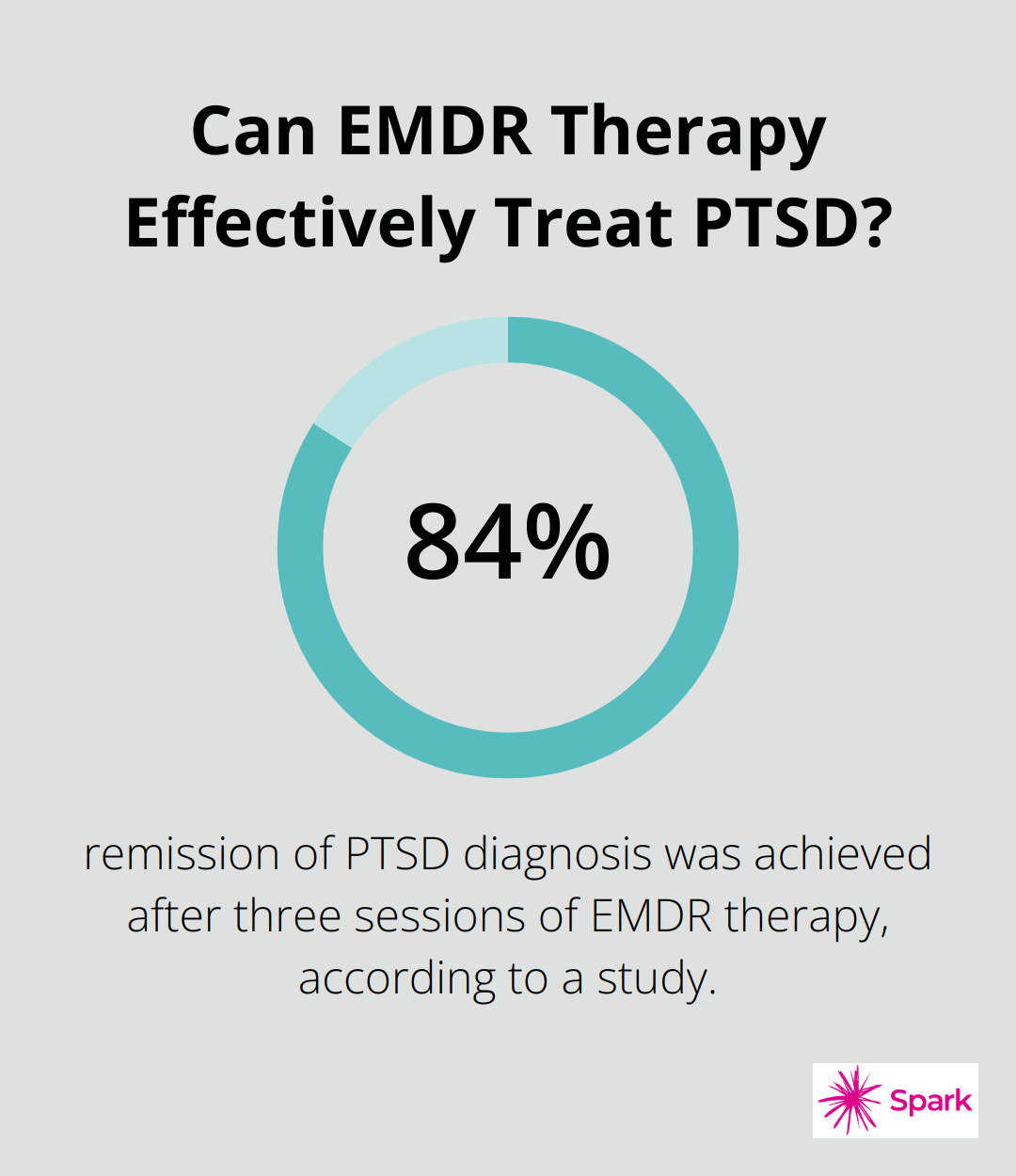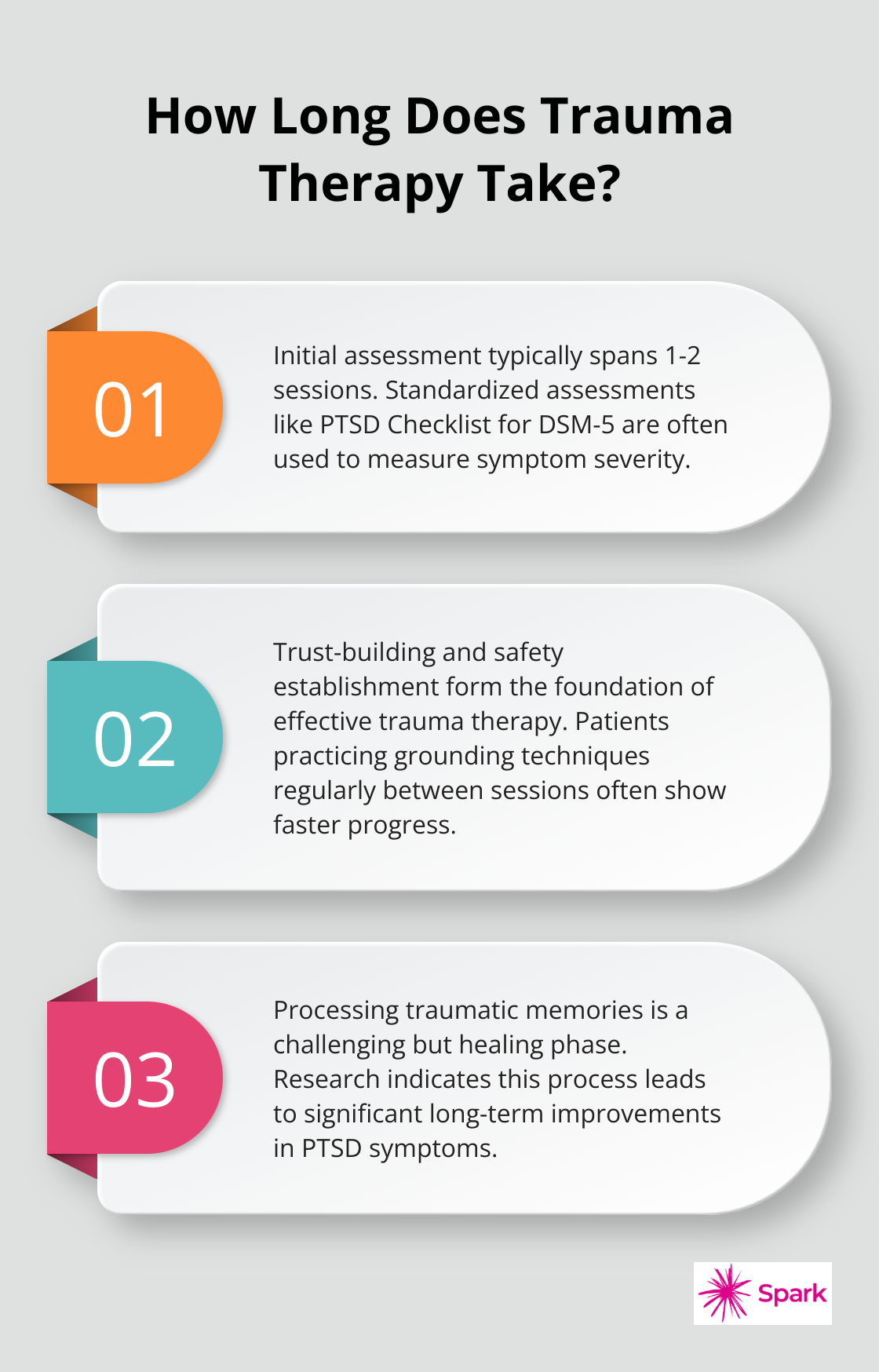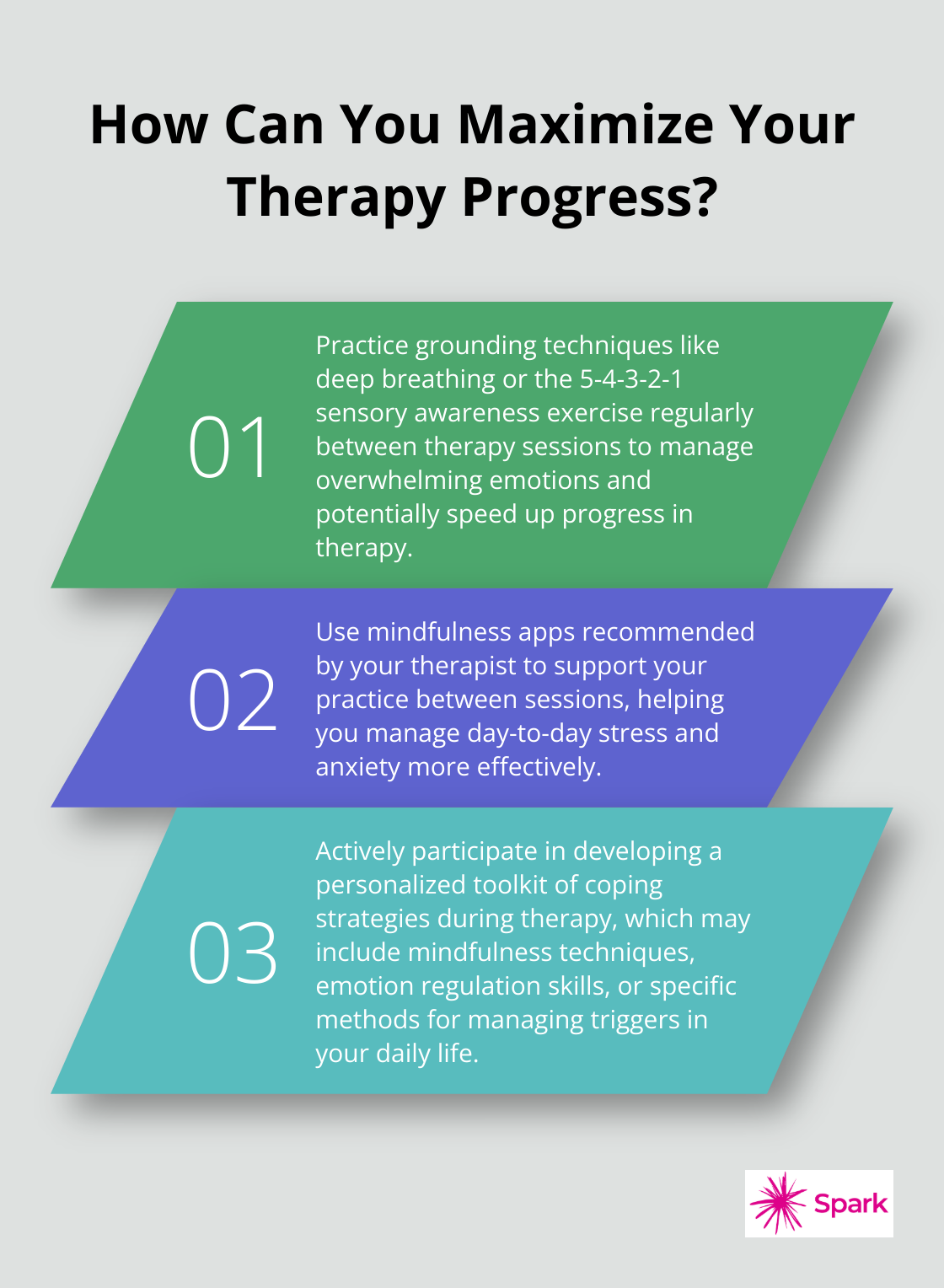Trauma can have a profound impact on mental health, affecting millions of people worldwide. At Spark Mental Health, we understand the importance of effective trauma therapy in helping individuals heal and reclaim their lives.
This comprehensive guide explores the various approaches to trauma therapy, from cognitive behavioral techniques to innovative treatments like EMDR. We’ll walk you through the process, helping you understand what to expect and how these therapies can support your journey to recovery.
What is Trauma Therapy?
Understanding Trauma and Its Impact
Trauma therapy is a specialized mental health treatment that helps individuals heal from psychological wounds caused by traumatic experiences. This form of therapy focuses on processing distressing memories, reducing symptom severity, and improving overall functioning.

The effects of trauma on mental health can be profound. About 5% of adults in the U.S. has PTSD in any given year. Symptoms often include intrusive thoughts, nightmares, avoidance behaviors, and heightened anxiety, which can significantly impair daily functioning and quality of life.
Types of Trauma
Trauma manifests in various forms, each requiring a tailored approach to treatment:
- Acute Trauma: Results from a single, intense event (e.g., a car accident or natural disaster).
- Chronic Trauma: Stems from prolonged exposure to stressful situations (e.g., ongoing abuse or neglect).
- Complex Trauma: Occurs when an individual experiences multiple, often interpersonal, traumatic events.
Understanding the specific type of trauma a person has experienced is essential for creating an effective treatment plan.
Goals and Principles of Trauma Therapy
The primary goal of trauma therapy is to help individuals process their traumatic experiences in a safe, controlled environment. This process involves:
- Establishing safety and stability
- Processing traumatic memories
- Developing healthy coping mechanisms
- Rebuilding a sense of self and relationships
Trauma-informed care principles guide this therapeutic approach. These principles, as outlined by the Substance Abuse and Mental Health Services Administration (SAMHSA), include safety, trustworthiness, peer support, collaboration, empowerment, and cultural sensitivity.
Evidence-Based Approaches
Effective trauma therapy often integrates various evidence-based approaches. For instance, Cognitive Processing Therapy (CPT) has shown statistically significant changes in PTSD and depression symptoms and improvement in end-state functioning.
Personalized care plays a critical role in trauma treatment. Telepsychiatry services (like those offered by Spark Mental Health) provide a safe, accessible way for individuals to engage in trauma therapy from the comfort of their own homes, reducing potential barriers to care.
As we explore the common trauma therapy approaches in the next section, you’ll gain a deeper understanding of the specific techniques used to address trauma and promote healing.
Effective Trauma Therapy Approaches
Cognitive Behavioral Therapy (CBT) for Trauma
CBT stands as a cornerstone in trauma therapy. This approach helps individuals identify and change negative thought patterns and behaviors associated with their traumatic experiences. A review of 23 clinical trials found that CBT for trauma resulted in remission, clinical improvement, and changes in symptoms.

In CBT sessions, therapists work with clients to:
- Identify trauma-related thoughts and beliefs
- Challenge and reframe these thoughts
- Develop coping strategies for managing triggers and symptoms
CBT typically involves 12-16 sessions, but the duration can vary based on individual needs.
Eye Movement Desensitization and Reprocessing (EMDR)
EMDR is a powerful technique that helps the brain process traumatic memories. The World Health Organization (WHO) recognizes EMDR as an effective treatment for PTSD. This approach involves bilateral stimulation (usually eye movements) while recalling traumatic memories.
During EMDR sessions, therapists guide clients through eight phases:
- History taking and treatment planning
- Preparation
- Assessment
- Desensitization
- Installation
- Body scan
- Closure
- Re-evaluation
A study found that three sessions of EMDR therapy resulted in an 84% remission of PTSD diagnosis with a large and significant pretreatment versus posttreatment effect size.
Somatic Experiencing
Somatic Experiencing focuses on the body’s physical responses to trauma. This approach, developed by Dr. Peter Levine, helps individuals release trapped trauma energy and restore the nervous system’s balance.
In Somatic Experiencing sessions, therapists help clients:
- Identify bodily sensations associated with trauma
- Develop resources for self-regulation
- Gradually process traumatic memories through bodily awareness
A study in the Journal of Traumatic Stress showed that Somatic Experiencing significantly reduced PTSD symptoms in tsunami survivors, with improvements maintained at 1-year follow-up.
Dialectical Behavior Therapy (DBT)
DBT, originally developed for borderline personality disorder, has shown effectiveness in treating complex trauma. This approach combines cognitive-behavioral techniques with mindfulness practices.
DBT-trained therapists focus on four key areas:
- Mindfulness: Staying present and aware
- Distress tolerance: Coping with difficult situations
- Emotion regulation: Managing intense emotions
- Interpersonal effectiveness: Improving relationships
Research published in Behaviour Research and Therapy found that DBT significantly reduced PTSD symptoms and improved overall functioning in individuals with complex trauma histories.
These evidence-based trauma therapy approaches offer various paths to healing. The next chapter will explore the process of trauma therapy, from initial assessment to the integration of new insights and behaviors.
The Journey of Trauma Therapy
Initial Assessment and Treatment Planning
Trauma-informed care acknowledges the need to understand a patient’s life experiences in order to deliver effective care. Your therapist will strive to understand your unique experiences, symptoms, and goals. This step is vital in creating a treatment plan that addresses your specific needs.

The initial phase typically spans 1-2 sessions. Therapists often use standardized assessments (such as the PTSD Checklist for DSM-5) to measure symptom severity. This provides a baseline to track progress throughout therapy.
Establishing Trust and Safety
Trust forms the foundation of effective trauma therapy. Your therapist will work to create a safe, non-judgmental environment where you feel comfortable sharing your experiences.
This phase often involves learning grounding techniques to manage overwhelming emotions. Simple exercises like deep breathing or the 5-4-3-2-1 sensory awareness technique can serve as powerful tools. Patients who practice these techniques regularly between sessions often show faster progress in therapy.
Processing Traumatic Memories
Once safety is established, therapy moves to processing traumatic memories. This phase often presents the most challenges, but also offers significant healing opportunities.
The approach may involve talking through memories, using EMDR techniques, or focusing on bodily sensations. It’s normal to experience temporary increases in distress during this phase. However, research indicates that this process leads to significant long-term improvements in PTSD symptoms.
Research supports the effectiveness of trauma-focused CBT for PTSD.
Developing Coping Skills
As you process traumatic memories, your therapist will help you build a toolkit of coping strategies. These may include mindfulness techniques, emotion regulation skills, or strategies for managing triggers.
Many therapists recommend mindfulness apps to support practice between sessions. Patients often find these tools helpful in managing day-to-day stress and anxiety.
Integrating New Insights
The final phase of trauma therapy focuses on integrating the insights and skills you’ve gained into your daily life. This may involve challenging negative beliefs about yourself or the world, rebuilding relationships, or pursuing goals that trauma may have derailed.
This phase is about reclaiming your life and moving forward. It’s not about forgetting what happened, but about reducing its power over your present and future.
Throughout this journey, healing isn’t linear. There will be ups and downs, but with persistence and support, significant progress is possible.
Final Thoughts
Trauma therapy offers a path to healing and recovery for those who have experienced psychological wounds. Through evidence-based approaches, individuals can process traumatic memories, develop coping skills, and rebuild their lives. The journey of trauma therapy involves several key stages, from initial assessment to integrating new insights.

Seeking professional help is vital for those who struggle with trauma. Trained therapists provide the support, guidance, and tools needed to navigate the complex emotions associated with trauma. At Spark Mental Health, we understand the unique challenges of trauma recovery and offer personalized telepsychiatry services that allow you to access trauma therapy from home.
Our team of experienced professionals provides evidence-based treatment, including cognitive-behavioral therapy and medication management when necessary. We strive to make trauma therapy as convenient and effective as possible (with flexible online scheduling and a commitment to accessibility). Trauma may have impacted your past, but with the right support and treatment, it doesn’t have to define your future.






